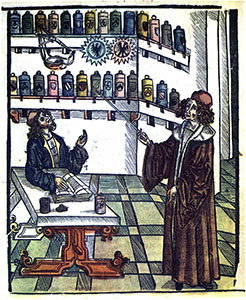
Spice store selling artists’ pigments.
It was customary in fifteenth-century Florence for the occupation of artist to be taken up mainly by the children of practising artists or by individuals from families that were not particularly wealthy since apprenticeship costs were lower than those of other professions.
To become a painter, it was therefore necessary to be accepted, at a young age, by a bottega - large studio/workshop premises in which the master painter not only plied his trade but might also have established his dwelling. Such studios were generally located at ground level and accessible from the street, perhaps displaying its wares for sale to passers-by.
The taking on of a pupil was regulated by a contract, signed before a notary public and in the presence of witnesses, in which the master undertook to train the young apprentice, who might or might not receive wages or be provided with board and lodging. In some cases, pupils judged by the master to have contributed only in small measure to the activity of the studio were required to pay a fee. Generally, an apprenticeship could last from a minimum of four years to a maximum of thirteen; initially, the pupil merely prepared colours and panels, and was only later introduced to the art of drawing and then actual painting.
These studios were authentic and true 'enterprises' with no rigid distinction between the various activities. Consequently, they produced articles of all types: from altarpieces to reliquaries, from public sculptures to wedding chests, from paperboard backing for embroidery work to glass window making. This kind of productive eclecticism still laboured under the Medieval conception of artists as artisan craftsmen, and only changed in the late Renaissance when artists' work came to be considered an intellectual activity in a turning point whose consequences linger to this day in the arbitrary distinction between higher and lower art forms.
In these studios, pupils not only learned about art as a trade but also received a broad cultural education. Often, then, in conjunction with their workshop apprenticeships, pupils would attend an 'abacus' or arithmetic school, normally the preserve of the children of merchants since, in addition to reading and writing, special emphasis was placed on 'reckoning with numbers'. These were 'professional induction' schools, distinct from the elite university education received exclusively by the literary humanists. Belonging to a class of educated citizens who could read, write and reckon in a society like that of Renaissance Italy, in which most of the population was illiterate, suggested that artists already belonged to an elite social category and explains why painters demanded, and were subsequently granted, membership of one of the Seven Arts, corporations formed in the Middle Ages to organize towns' economic activities, from the commerce to the finance and from the manufacturing industry to the craftsmanship. The use of various types of earth and pigments in the preparation of colouring compounds to be spread on the panels in some ways placed artists on a par with the physicians of the day who treated the sick with medicinal herbs, plant essences and mineral powders. Furthermore, both categories obtained substances required for their profession from apothecaries. These were the conditions that enabled artists to become members of The Guild of Physicians and Apothecaries, although in a subordinate position in relation to the latter who remained the artists' suppliers of raw materials.
Serena Nocentini